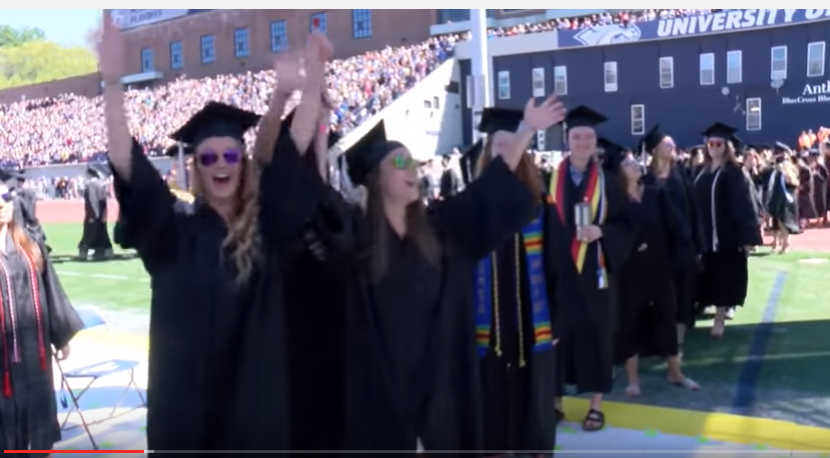By Sara Swann,
OpenSecrets.org
With the end of summer fast approaching comes another year of rising college tuition costs and looming student loans.
College tuition has increased over the past several decades, but in the last 10 years the average cost of tuition for four-year public colleges and universities has grown at a lower rate than previous decades. Still, the price tag for college is not cheap. For the average four-year public institution, tuition can cost about $9,650, according to College Board. The average tuition total for private non-profit institutions is more than triple that at $33,480.
 These high tuition costs have inevitably led to more students taking out loans in order to afford their education. Across the United States, there are more than 44 million student loan borrowers who have accrued approximately $1.3 trillion in student loan debt, according to Forbes.
These high tuition costs have inevitably led to more students taking out loans in order to afford their education. Across the United States, there are more than 44 million student loan borrowers who have accrued approximately $1.3 trillion in student loan debt, according to Forbes.
The student loan industry is a major player in money in politics, but was not as active in 2016 as it has been in the past. For the 2016 election cycle, student loan companies gave just over $982,000 in contributions to federal candidates, parties and outside groups. The industry reported more than $1 million in contributions for both the 2014 and 2012 cycles.
Roughly three-quarters of the industry’s contributions for 2016 went to Republican candidates and parties. The student loan industry has allocated more of its contributions to Republicans than Democrats in every cycle since 1996.
The top three student loan companies making campaign contributions in 2016 were College Loan Corp with $668,000 donated, Navient Corp with almost $283,000, and NelNet Inc with just under $168,000. All three companies gave the majority of their contributions to Republican and conservative candidates and parties.
Student loan companies are even more active in the lobbying world, spending more than $4.4 million on lobbying efforts in 2016. The top lobbying client by far in 2016 was Navient Corp with more than $2 million spent. Other major lobbying spenders for the industry last year were NelNet Inc and SLM Corp with $620,000 and $570,000, respectively.
Last year these companies mainly lobbied on issues related to student loans, particularly federal credit programs, student borrowing and loan servicing, IRS private debt collection and Title IV of the Higher Education Act, which aims to make grants and other benefits available to eligible students seeking post-secondary education. So far in 2017, student loan companies have spent roughly $3.6 million on lobbying.
Student loan companies aren’t the only ones getting political — colleges and universities are, too. For the 2016 election cycle, the education industry had a record-high contribution total of almost $81 million. Nearly all of this money is donated by school employees, such as professors, since most non-profit educational institutions do not have political action committees. Of the contributions to political candidates and parties, Democrats received 86 percent — the most significant liberal lean in the industry’s history. Since 1990, the education industry has never given less than 58 percent of its contributions to Democrats, with an overall average of 77 percent going to the left.
The higher education institutions with affiliates who gave the most money during the 2016 election were the University of California system (roughly $4.4 million), Stanford University (almost $2.3 million) and Harvard University (more than $1.6 million). Every university among the sector’s top 20 donors made at least 83 percent of its contributions to Democrats.
Democratic presidential nominee Hillary Clinton received the most money from the education industry in 2016 by far, with a total of approximately $23.7 million. Her primary challenger Sen. Bernie Sanders (I-Vt.) came in second with almost $5.5 million, while her general election opponent Donald Trump was further down the list of top recipients at No. 8, with a total of about $778,000.
In recent years, the education industry’s lobbying spending has been on a downward slope, and 2016 was no exception. The industry’s lobbying total was about $74.4 million — over $3.6 million less than its 2015 total and $35 million short of the industry’s record-high lobbying total from 2010.
Last year, the biggest lobbying clients in the education industry were the Association of American Medical Colleges (more than $2.8 million), Apollo Education Group (about $1.4 million) and the education-related subsidiaries of Warburg Pincus (just over $1.1 million). The top education-related issues these groups focused on included cuts to graduate and professional student loan benefits, global health learning opportunities, financial aid (including Pell Grants), campus sexual assault and post 9/11 G.I. bill benefits.
